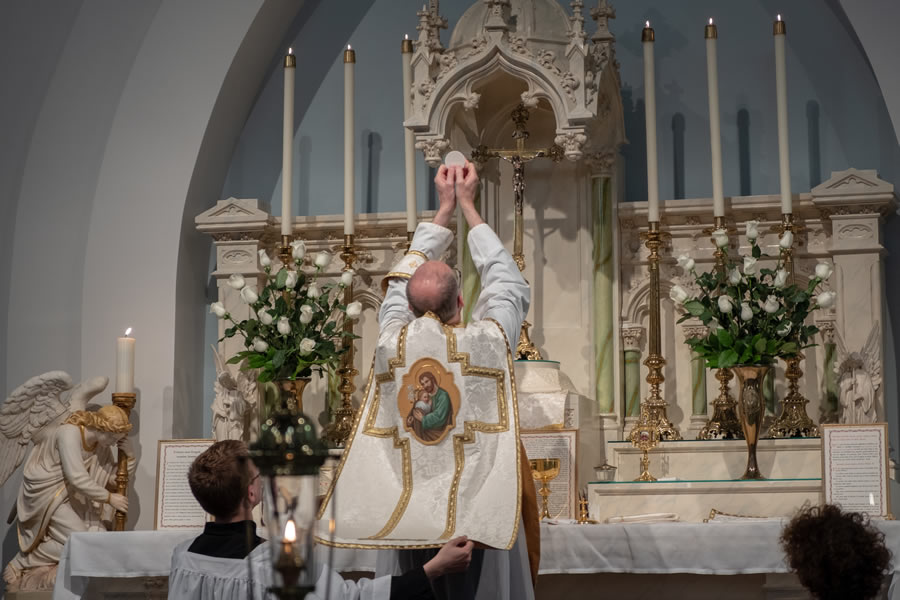
Quo Vadis?
08-01-2021Pastor's LetterFr. John BonavitacolaDear Friends,
Quo Vadis? You probably remember the 1951 film and the title means, in Latin, “where are you going?” Recently Pope Francis issued new directives (Traditiones Custodes) actually restrictions, on the use of the pre-Vatican II Missal or the celebration of the Extraordinary form of the Mass (often referred to as the TLM or traditional Latin Mass). Where is he going with this and why? A little bit of history is needed to understand how we got here in the first place.
The Second Vatican Council issued a new missal for the Mass, commonly referred to as the Novus Ordo (new Order of Mass) or the missal of Paul VI. The previous missal was issued by Pius V in 1576 and slightly updated by Pope John XXIII in 1962. After the Council the missal of Pius V/ John XXIII was no longer permitted to be used. Hence as some of you may recall the “new Mass” replaced the Tridentine Mass. Not everyone was happy about the change. Some found it hard to adjust to the swift changes. Archbishop Marcel Lefebvre, a French bishop refused to acknowledge the changes and continued to celebrate the Tridentine Mass. Over time he attracted many followers. Eventually he ordained a few bishops without the consent of the Pope and when he did, Pope John Paul II excommunicated him.
However, Pope John Paul II realized that many people were still very connected to the pre-Vatican II Mass and desiring to reconcile Lefebvre’s followers permitted each Bishop to allow for a very limited use of the Tridentine Mass in a diocese. That was in the early 1990’s and some bishops gave permission and some did not. Along comes Pope Benedict XVI who wanted to further the reconciliation and healing of the divisions in the Church that the changes in the Mass brought about, and he granted permission for any priest to celebrate the Tridentine Mass (use the Missal of John XXIII) without needing the permission of the local Bishop.
As a result, the use of the Tridentine Mass and rituals increased throughout the world. In our Diocese, Bishop Olmsted allowed for a separate parish (Mater Misericordia) in the east Valley to offer all the sacraments according the pre-Vatican II way of doing things. This has been a stable community for some time in our diocese. In other Parishes, priests can and often do offer the, what Pope Benedict referred to as the Extraordinary form of the Mass (as opposed to the Ordinary form which is the Vatican II Mass or Novus Ordo) if there is a need.
The one caveat that both John Paul II and Benedict XVI insisted on, is that those who celebrate using the pre-Vatican II Missal, acknowledge the legitimacy of the Second Vatican Council and the Missal of Paul VI or the “new Mass”. Their goal was to heal the schism caused by Archbishop Lefebvre and not create another one. In fact, Pope Benedict, lifted the excommunication of Lefebvre and his followers in hopes of reconciliation.
Now comes Pope Francis. He inquired from the world’s bishops how this was all working and whether or not John Paul’s and Benedict’s goals of healing divisions was happening. According the document that Pope Francis issued, the response of the Bishops, in the majority, was that the divisions were only getting worse. Many of the groups using the older Missal were more emphatic at denying the legitimacy of Vatican II and the use of the Missal of Paul Vl. Again, according to the document, Pope Francis wanting to stop the divisiveness, revoked the permission that Pope Benedict gave. As a result, the celebration of the Tridentine Mass is now only allowed with the permission of the local Bishop, the Tridentine Mass is not to be celebrated in Parish Churches. What all this comes down to is that Pope Francis is greatly limiting the use of the Tridentine Mass and rites. His position is that the experiment of Pope Benedict to bring the two sides closer together and mutually enrich each other is not working.
And to be clear, this does not mean that you can not offer the Novus Order mass in Latin. The Mass of Vatican II can be offered in any language including Latin, it can be offered with the priest facing the people or ad orientem. That has not changed.
From my point of view as a Pastor, the document Traditiones Custodes is very heavy handed. I would have preferred to see an approach where the Bishops were encouraged to work with these groups and try to steer them away from any anti-Vatican II mentality, negativity towards the Novus Ordo and any elitism that was creeping into these groups. But I was not consulted. Imagine that! Actually, that has been the problem from the start. Priests and Pastors were never consulted in the late 1960’s about the changes, they were just told to make the changes. Not a great strategy to get people to buy into changes.
Where do we go from here? So far, our Bishop has not made any decisions on how to implement these new restrictions. But all in all, the restrictions have caused a lot of hurt and anger which seems to me to only cause more division and not less. Sadly, divisiveness is the mark of our age. Where are we going with all this? Who knows? But we can make the Prayer of St. Francis our own: Make me a channel of your peace. If we each commit to that, then we can go in the direction of unity. We may not get there anytime soon but we can be an instrument of His peace.
Quo vadis?
Love, Fr. John B.
BACK TO LIST